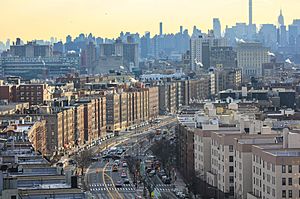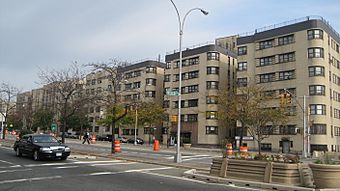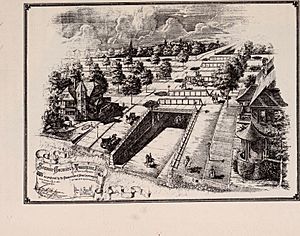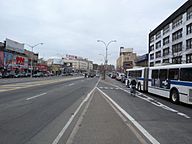Grand Concourse (Bronx) facts for kids
| Grand Boulevard and Concourse | |

Looking southward from 179th Street with Manhattan in the background
|
|
| Owner | City of New York |
|---|---|
| Maintained by | NYCDOT |
| Length | 5.2 mi (8.4 km) |
| Location | Bronx, New York City |
| South end | |
| North end | |
| Construction | |
| Construction start | 1894 |
| Completion | 1909 |
| Other | |
| Designer | Louis Aloys Risse |
|
Grand Concourse Historic District
|
|

Art Deco apartment buildings along Grand Concourse
|
|
| Location | The Bronx, New York |
| Architectural style | Late 19th and 20th Century Revivals, Art Deco |
| NRHP reference No. | 87001388 |
| Significant dates | |
| Added to NRHP | August 24, 1987 |
The Grand Concourse is a major street in The Bronx, a part of New York City. It is also known as the Grand Boulevard and Concourse. This important road stretches for about 5.2 miles (8.4 km) through many Bronx neighborhoods. These include Bedford Park, Concourse, Fordham, and Mott Haven. For most of its length, the Concourse is very wide, about 180 feet (55 m) across.
The Grand Concourse was designed by Louis Aloys Risse, an engineer from France. He first thought of the road in 1890. It was built between 1894 and 1909, with an extension added in 1927. The creation of this boulevard led to many apartment buildings being built around it. By 1939, people called it "the Park Avenue of middle-class Bronx residents."
However, the area faced tough times in the 1960s and 1970s. Many buildings became run-down, and the Concourse was changed to be more friendly for cars. Starting in the 1980s, efforts began to fix up and rebuild the area. A big part of the Grand Concourse was reconstructed in the 2000s.
The southern part of the Grand Concourse has many historic homes. These buildings were recognized as the Grand Concourse Historic District in 1987. In 2011, the New York City Landmarks Preservation Commission also named many buildings along the Concourse as city landmarks. You can also find important places like the Bronx Museum of the Arts and the Edgar Allan Poe Cottage near the Concourse.
Contents
Exploring the Grand Concourse
The Grand Concourse starts at 138th Street in the south. It soon connects with the Major Deegan Expressway. The Concourse then becomes a wide road with eight lanes, split into two directions. This continues until 161st Street.
Roadways and Bike Paths
North of 161st Street, the Concourse gets "service roads" on each side. These are like smaller roads running next to the main one. There are also special bike lanes on the service roads. For a short part, the Concourse has ten lanes with four separate roadways.
Just before 165th Street, the main roads in the middle join up. They become a five-lane road with two lanes going each way and a center lane for left turns. The special bike lanes on the service roads end at 171st Street. Regular bike lanes then start on the right side of the service roads. This setup, with two service roads and one main road, continues north. The Grand Concourse finally ends at Mosholu Parkway.
At Fordham Road, the main road goes under the intersection. This helps traffic flow smoothly. The service roads, however, cross Fordham Road directly.
Public Transportation Along the Concourse
The New York City Subway's IND Concourse Line (B D trains) runs underneath the Grand Concourse. This happens between about 161st and 204th Streets. Another subway line, the IRT Jerome Avenue Line (4 and 5 train), also runs under a small part of the boulevard near 149th Street.
For bus riders, the Bx1 local bus and the BxM4 express bus travel the entire length of the Grand Concourse. The Bx2 local bus also runs on the Concourse north of 149th Street.
The Story of the Grand Concourse
Building a Grand Boulevard
Louis Risse first imagined the Grand Concourse in 1890. He wanted to connect Manhattan to the northern part of the Bronx. Construction started in 1894, and the road opened to traffic in November 1909.
The Concourse was built during a time called the "City Beautiful movement." This movement aimed to make cities more beautiful and grand. The Grand Concourse was designed to be like the famous Champs-Élysées in Paris. But it is much bigger! It stretches about four miles (6 km) long and is 180 feet (55 m) wide. It has three separate roadways with tree-lined areas in between. This design meant some smaller streets did not cross the main Concourse. The whole project cost $14 million, which was a huge amount of money back then.
Originally, the Grand Concourse went from Bronx Borough Hall at 161st Street north to Van Cortlandt Park. In 1927, it was extended southward to 138th Street. This happened after Mott Avenue was made wider to fit the boulevard. You can still see signs at the 149th Street–Grand Concourse station that say "Mott Avenue," showing its old name.
Growth and Development
The opening of the Jerome Avenue subway line in 1917 helped the area grow. Many families, especially Jewish and Italian immigrants, moved from crowded Manhattan to the Bronx. They were looking for better homes.
In 1923, Yankee Stadium opened near the Grand Concourse at 161st Street. This brought more excitement to the area. Later, in 1929, the grand Loew's Paradise movie theater was built. It was one of the biggest movie theaters in New York City at the time.
The opening of the Independent Subway System's Concourse Line in 1933 further boosted development. By the mid-1930s, nearly 300 apartment buildings lined the Concourse. These buildings were usually five or six stories tall. They often had wide entrance courtyards with grass and shrubs. Many of them are great examples of Art Deco and Art Moderne architecture.
Even with the Great Depression happening, new apartment buildings continued to be built. The government also helped with projects on the Grand Concourse through programs like the WPA. In 1934, almost all homes in the Bronx had private bathrooms and central heating. The WPA Guide to New York City in 1939 called the Grand Concourse "the Park Avenue of middle-class Bronx residents." Having an apartment there showed you were doing well.
A Period of Decline
In the 1960s, the southern and central Bronx areas started to decline. People stopped investing in real estate there. This was made worse by city planning programs and unfair housing practices (called redlining). Many white residents moved to the suburbs. At the same time, African Americans and Puerto Ricans moved to the Bronx for jobs. However, these jobs were moving away.
Due to unfair practices, these new residents often couldn't move to the suburbs. They were forced into older, declining city housing. Buildings along the Concourse became seen as old and cheap to rent. Landlords paid less attention to their buildings, and banks stopped giving financial support. More people left between 1968 and 1970, and many middle-class residents moved away. Many buildings were damaged by fires, vandalism, and lack of care.
The road itself was also changed to be more car-friendly. In the 1960s, the grassy areas in the middle of the Concourse were removed and replaced with green-painted cement. By the 1980s, The New York Times called the Concourse "a driver’s paradise." Traffic lights were timed to create a "green wave," allowing cars to move through intersections without stopping. But this meant fewer places for pedestrians to cross, and trees were removed.
Bringing Back the Grand Concourse
Rebuilding the Boulevard
In the 1980s, building owners along the Concourse began fixing up their properties. The Bronx Museum of the Arts moved to a former synagogue on the Concourse in 1982. In 1989, the city created the "Special Grand Concourse Preservation District." This helped protect the unique character of the residential buildings. New buildings started to appear in the 1990s, like the Bronx Housing Courthouse.
Small shops also began opening in basements along the Concourse in the 1980s. These shops served the local communities. By 2003, a writer for The New York Times noted that "every block between 161st Street and 196th Street now has a grocery, a barber shop, a travel agency or a medical clinic."
By the early 1990s, local leaders wanted to make the Concourse safer for people walking. It was one of the most dangerous streets in New York City. In 1991, twelve pedestrians died there. In 1992, the New York City Department of Transportation (NYCDOT) studied the Concourse. They made improvements like adding left-turn signals, pedestrian barriers, and new signs. These changes continued until 2006.
As a test, the NYCDOT completely rebuilt the section between 161st Street and 167th Streets starting in 1999. This $18 million project widened and landscaped the grassy areas in the middle. It also improved lighting, added new signs, and created bike lanes. As a result, accidents in this section dropped by 69% between 1998 and 2005. The final part of this test project was finished in 2008.
Because the test project was successful, the NYCDOT planned a four-phase project for the Concourse. This project would rebuild the area between 161st Street and Fordham Road. The test project was the first phase. Reconstruction of the Concourse between 166th and 171st Street began in 2013 and finished in June 2017. More funding is planned for the section from 171st Street to 175th Street. In January 2017, planning started for the fourth phase, which will renovate the section between 175th Street and Fordham Road.
Changes and New Residents
Because of its beautiful Art Deco buildings and its closeness to Manhattan, the southern part of the Concourse has been changing. Many young professionals are moving to the area. Since the 2000s, real estate agents have called the area around the Grand Concourse a "renewal." New residents are moving in, and serious crime rates have gone down a lot.
The New York Times spoke to residents who believed that while the area would see changes, it would still be a place for working-class, "community-oriented" people. They felt it would not become like other neighborhoods that have become very expensive.
Important Buildings Along the Concourse
Many important buildings are located along the Grand Concourse. These buildings are significant for their history and their current use. Several are recognized as New York City Landmarks (NYCL) or are listed on the National Register of Historic Places (NRHP). Here are some of them, listed from south to north:
- 475 Grand Concourse – This is home to Hostos Community College.
- 558 Grand Concourse – The Bronx General Post Office (NRHP, NYCL) was built between 1935 and 1937. Inside, you can see famous murals created in 1939 by Ben Shahn and Bernarda Bryson Shahn.
- 851 Grand Concourse – The Bronx County Courthouse (NRHP, NYCL) was built from 1931 to 1934.
- 1040 Grand Concourse – This building houses The Bronx Museum of the Arts. It was built in 1961 and became a museum in 1982.
- 1125 Grand Concourse – The Andrew Freedman Home (NYCL) was built in 1924. It was later turned into a small hotel.
- 1150 Grand Concourse – This is known as The Fish Building, built in 1937.
- 2403 Grand Concourse – The Loew's Paradise Theater (NYCL) was built in 1929.
- 2516-2530 Grand Concourse – The Dollar Savings Bank Building (NYCL) was built in several stages from 1932 to 1952. It was the headquarters of a bank and has a clock tower on top.
- 2640 Grand Concourse – This is the Poe Cottage (NRHP, NYCL), built in 1812. It was the last home of the famous writer Edgar Allan Poe.
Grand Concourse Historic District
In 2011, the New York City Landmarks Preservation Commission named the Grand Concourse from 153rd to 167th Streets as part of the Grand Concourse Historic District. Before this, the State of New York had already suggested that many buildings along the Concourse be listed on the National Register of Historic Places as a historic district.






